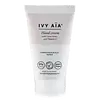Olive & June Hand Serum Versus IVY AÏA Hand Cream
What's inside
What's inside
 Key Ingredients
Key Ingredients

 Benefits
Benefits

 Concerns
Concerns

 Ingredients Side-by-side
Ingredients Side-by-side

Water
Skin ConditioningVitis Vinifera Seed Oil
EmollientCaprylhydroxamic Acid
1,2-Hexanediol
Skin ConditioningPropanediol
SolventGlycerin
HumectantPersea Gratissima Oil
Skin ConditioningSpondias Mombin Pulp Extract
Skin ConditioningMangifera Indica Pulp Extract
Skin ConditioningMusa Sapientum Pulp Extract
Skin ConditioningCetearyl Alcohol
EmollientPotassium Cetyl Phosphate
EmulsifyingSimmondsia Chinensis Seed Oil
EmollientIsosorbide Dicaprylate
Skin ConditioningCereus Grandiflorus Flower Extract
Skin ConditioningHelianthus Annuus Seed Oil
EmollientHydrolyzed Hyaluronic Acid
HumectantPanthenol
Skin ConditioningGlyceryl Stearate
EmollientSodium Acrylate/Sodium Acryloyldimethyl Taurate Copolymer
Emulsion StabilisingPolyisobutene
Caprylyl Glucoside
CleansingMyristyl Myristate
EmollientTocopheryl Acetate
AntioxidantXanthan Gum
EmulsifyingDisodium EDTA
Ascorbic Acid
AntioxidantWater, Vitis Vinifera Seed Oil, Caprylhydroxamic Acid, 1,2-Hexanediol, Propanediol, Glycerin, Persea Gratissima Oil, Spondias Mombin Pulp Extract, Mangifera Indica Pulp Extract, Musa Sapientum Pulp Extract, Cetearyl Alcohol, Potassium Cetyl Phosphate, Simmondsia Chinensis Seed Oil, Isosorbide Dicaprylate, Cereus Grandiflorus Flower Extract, Helianthus Annuus Seed Oil, Hydrolyzed Hyaluronic Acid, Panthenol, Glyceryl Stearate, Sodium Acrylate/Sodium Acryloyldimethyl Taurate Copolymer, Polyisobutene, Caprylyl Glucoside, Myristyl Myristate, Tocopheryl Acetate, Xanthan Gum, Disodium EDTA, Ascorbic Acid
Water
Skin ConditioningGlycerin
HumectantParaffinum Liquidum
EmollientCetearyl Alcohol
EmollientIsopropyl Myristate
EmollientPrunus Amygdalus Dulcis Oil
Skin ConditioningStearic Acid
CleansingGlyceryl Stearate
EmollientCeteareth-20
CleansingDimethicone
EmollientAluminum Starch Octenylsuccinate
AbsorbentPhenoxyethanol
PreservativeButyrospermum Parkii Butter
Skin ConditioningTheobroma Cacao Seed Butter
EmollientTocopheryl Acetate
AntioxidantAllantoin
Skin ConditioningXanthan Gum
EmulsifyingEthylhexylglycerin
Skin ConditioningSodium Phytate
Glycine Soja Oil
EmollientTocopherol
AntioxidantLactic Acid
BufferingSodium Hyaluronate
HumectantBeta-Sitosterol
Emulsion StabilisingSqualene
EmollientWater, Glycerin, Paraffinum Liquidum, Cetearyl Alcohol, Isopropyl Myristate, Prunus Amygdalus Dulcis Oil, Stearic Acid, Glyceryl Stearate, Ceteareth-20, Dimethicone, Aluminum Starch Octenylsuccinate, Phenoxyethanol, Butyrospermum Parkii Butter, Theobroma Cacao Seed Butter, Tocopheryl Acetate, Allantoin, Xanthan Gum, Ethylhexylglycerin, Sodium Phytate, Glycine Soja Oil, Tocopherol, Lactic Acid, Sodium Hyaluronate, Beta-Sitosterol, Squalene
Ingredients Explained
These ingredients are found in both products.
Ingredients higher up in an ingredient list are typically present in a larger amount.
Cetearyl alcohol is a mixture of two fatty alcohols: cetyl alcohol and stearyl alcohol. It is mainly used as an emulsifier. Emulsifiers help prevent the separation of oils and products. Due to its composition, it can also be used to thicken a product or help create foam.
Cetearyl alcohol is an emollient. Emollients help soothe and hydrate the skin by trapping moisture.
Studies show Cetearyl alcohol is non-toxic and non-irritating. The FDA allows products labeled "alcohol-free" to have fatty alcohols.
This ingredient is usually derived from plant oils such as palm, vegetable, or coconut oils. There is debate on whether this ingredient will cause acne.
Due to the fatty acid base, this ingredient may not be Malassezia folliculitis safe.
Learn more about Cetearyl AlcoholGlycerin is already naturally found in your skin. It helps moisturize and protect your skin.
A study from 2016 found glycerin to be more effective as a humectant than AHAs and hyaluronic acid.
As a humectant, it helps the skin stay hydrated by pulling moisture to your skin. The low molecular weight of glycerin allows it to pull moisture into the deeper layers of your skin.
Hydrated skin improves your skin barrier; Your skin barrier helps protect against irritants and bacteria.
Glycerin has also been found to have antimicrobial and antiviral properties. Due to these properties, glycerin is often used in wound and burn treatments.
In cosmetics, glycerin is usually derived from plants such as soybean or palm. However, it can also be sourced from animals, such as tallow or animal fat.
This ingredient is organic, colorless, odorless, and non-toxic.
Glycerin is the name for this ingredient in American English. British English uses Glycerol/Glycerine.
Learn more about GlycerinGlyceryl Stearate is a mix of glycerin and stearic acid.
It is used to stabilize the mixing of water and oil ingredients. By preventing these ingredients from separating, it can help elongate shelf life. It can also help thicken the product's texture.
As an emollient, it helps soften skin and supports barrier-replenishing ingredients.
In cosmetics, Glyceryl Stearate is often made from vegetable oils or synthetically produced.
This ingredient may not be fungal-acne safe
Fun fact: The human body also creates Glyceryl Stearate naturally.
Learn more about Glyceryl StearateTocopheryl Acetate is AKA Vitamin E. It is an antioxidant and protects your skin from free radicals. Free radicals damage the skin by breaking down collagen.
One study found using Tocopheryl Acetate with Vitamin C decreased the number of sunburned cells.
Tocopheryl Acetate is commonly found in both skincare and dietary supplements.
Learn more about Tocopheryl AcetateWater. It's the most common cosmetic ingredient of all. You'll usually see it at the top of ingredient lists, meaning that it makes up the largest part of the product.
So why is it so popular? Water most often acts as a solvent - this means that it helps dissolve other ingredients into the formulation.
You'll also recognize water as that liquid we all need to stay alive. If you see this, drink a glass of water. Stay hydrated!
Learn more about WaterXanthan gum is used as a stabilizer and thickener within cosmetic products. It helps give products a sticky, thick feeling - preventing them from being too runny.
On the technical side of things, xanthan gum is a polysaccharide - a combination consisting of multiple sugar molecules bonded together.
Xanthan gum is a pretty common and great ingredient. It is a natural, non-toxic, non-irritating ingredient that is also commonly used in food products.
Learn more about Xanthan Gum